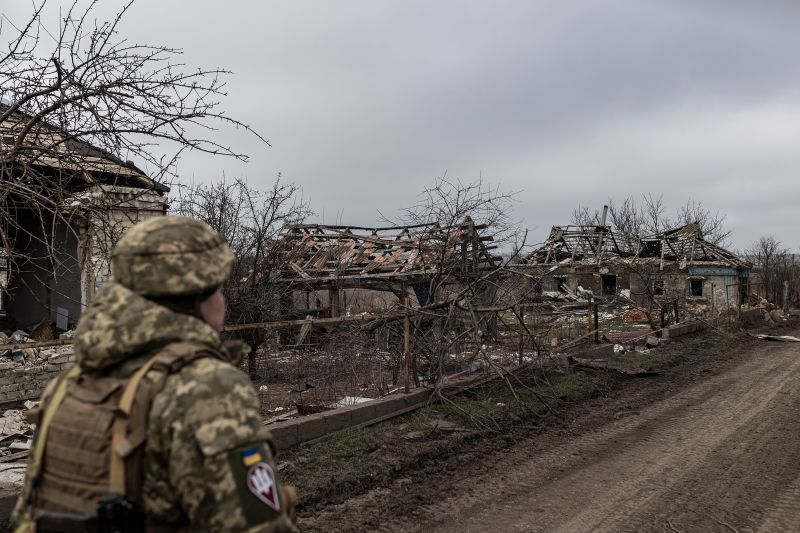
Russia’s new guided bomb inflicts devastation and heavy casualties on the Ukrainian front lines
Russia has begun using a powerful aerial bomb that has decimated Ukrainian defenses and tilted the balance on the front lines. It has done so by converting a basic Soviet-era weapon into a gliding bomb that can cause a crater fifteen meters wide.
The bomb is the FAB-1500, essentially a 1.5-tonne weapon of which nearly half comprises high explosives. It is delivered from above by fighter jets from a distance of some 60-70 kilometers, out of range of many Ukrainian air defenses. The FAB-1500 is another example of how Russia is fighting its war in Ukraine, inflicting massive destruction before trying to take territory.
Recent videos from the battlelines in Donetsk region have illustrated the immense power of these bombs as they have hit thermal power plants, factories and tower blocks – places from which the Ukrainians coordinate their defenses.
The FAB-1500 is directed towards its target by a guidance system and pop-out wings that allow it to glide towards its target. Joseph Trevithick, who has written about the development of the bomb for TheWarZone, says they “offer a new and far more destructive stand-off strike option for many of Russia’s tactical jets that also help pilots stay further away from enemy defenses.”
“Why they are using the FAB-1500? Because the damage done by it is very serious. If you survive, you are guaranteed to have a contusion.”
“It puts a lot of pressure on soldiers’ morale. Not all of our guys can withstand it. While they are more or less used to the FAB-500 by now, but the FAB-1500 is hell.”
The use of FAB bombs has become a critical element in the Russian offensive in Donetsk region, especially in razing to the ground Ukrainian defenses in and around Avdiivka, which fell in February.
The FAB-1500 is the most powerful in a family of Soviet-era ‘dumb bombs’ now being converted at a plant near Moscow into a cheap but potent version of a missile.
Justin Bronk, a senior research fellow at the Royal United Services Institute in London, says that “while manufacturing the glide kits is a bottleneck, the basic explosive package is something they have in huge numbers.”
So the Russians have very heavy firepower to bring to bear on fixed defenses, increasing Ukrainian casualties, though not as yet enough to fundamentally change the frontlines.
Russian military bloggers began referring to the weapon last September when its accuracy was being tested. The Fighterbomber telegram channel noted that “after many months of trials and errors,” a FAB-1500 had “accurately” hit its “combat target” for the first time.
Fighterbomber, which is close to the Russian military and has nearly half-a-million subscribers, claimed that the newly developed glide kit had increased the range of the bombs. It also said the FAB-1500 was accurate to within five meters.
Within a few weeks, both Ukrainian and Russian sources spoke of the use of the massive bomb in Kherson in the south and Kharkiv in the north.
Then in January, Russian Defense Minister Sergey Shoigu was seen toured the plant of the JSC Tactical Missiles Corporation – a major arms manufacturer – in the Moscow region, being shown the wrap-around wings developed for the bomb. According to the Ministry video, the company said it had developed “a high-precision” munition converting old free-fall bombs into weapons that would glide to their target.
The director of the plant proudly reported to Shoigu that productivity had increased by 40% as it had shifted to 24/7 production.
Bronk notes that the converted FAB bombs can only be used against fixed targets, but in the grinding attritional war in the east, the main Ukrainian positions are generally known to the Russians.
The Russian planes dispatching these bombs are not invulnerable. The Ukrainian air force has claimed that it has brought down several Su-34 fighters in recent weeks. But most Ukrainian air defenses do not have the range to hit planes some 70 kilometers away.
“The attack aviation Su-35 and Su-34 bombers don’t approach as close as they would like to. Still, if we had more long-range air-defense we would be able to take down these jets further [from our frontlines],” Ihnat added.
Bronk says the development of the glide bombs has given the Russians a way to use their tactical air force (as opposed to long-range bombers) more effectively after its limited role in the first phase of the war. He says the US Patriot complex is just about the only defense that has the range to counter the threat, but the Ukrainians have a limited number. And the missiles used by Patriots are in short supply given the delay in the US Congress passing a further package of military aid for Ukraine.
Ukrainian officials from President Volodymyr Zelensky downwards have almost daily pleaded for longer range air defense weapons to fend off the Russian aerial threat. The F-16 combat aircraft on which Ukrainian pilots are now training are unlikely to take to the skies over Ukraine until the second half of the year but may force Russian combat aircraft to stay further away.
In the meantime, Ukrainian forces on the frontlines, especially in Donetsk, are exposed to a blitz of Russian air strikes – sometimes more than 100 in a day, according to the Ukrainian General Staff.
Just as the Russians previously wiped out Ukrainian positions with intensive artillery, they are now using a seemingly inexhaustible supply of these devastating bombs to leave Ukrainian forces with nothing to defend and nowhere to shelter.
